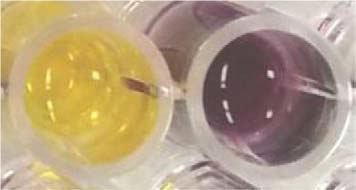Background
Approximately 300 million people will die prematurely as a result of antimicrobial drug resistance over the next 35 years resulting in the loss of 60 and 100 trillion USD worth of economic output by 2050 if the spread of antimicrobial drug resistance is not brought under control. Misdiagnosis of bacterial infection and overuse of antibiotics both contribute to antibiotic resistance. It is estimated that per cent of all antibiotic prescriptions world-wide are for β-lactam antibiotics (e.g. penicillins, cephalosporins, carbapenems), thus the emergence of wide-spread resistance to this class of antibiotics is of particular concern. Current beta-lactamase assay kits utilize Nitrocefin, which is expensive to synthesize, requires refrigerated storage, and has limited applicability to detecting only a sub-set of beta-lactamase producing bacterium. Thus it is imperative to develop diagnostic methods that more quickly, conveniently, and broadly identify the presence of beta-lactamase activity so that an appropriate antibiotic therapeutic strategy is selected.
Description of the invention
A novel chromogenic composition of matter (Aubergen2) has been synthesized that provides a deep purple colour change upon reaction with a broad spectrum of bacterial produced beta-lactamase. The colour change observed is substantially more distinct than Nitrocefin, the current commercial chromogenic beta-lactamase detection substrate.
Advantages
- Synthesis methodology less expensive than Nitrocefin
- Sharper colour transition enabling detection at lower beta-lactamase concentration
- Is water soluble thus does not rely on DMSO solvent (cited as neurotoxin, linked to severe allergic reactions, and can permeate nitrile rubber gloves thus potentially carrying other toxic substances into the skin)
- Broad detection for all classes of beta-lactamase producing bacterium
- Opens up possibility of more convenient diagnostic form factors (eg. sensors, strips, discs, sprays, etc)
Potential applications
- Detection of β-lactam antibiotic resistance in bacterial isolates
- Detection of β-lactam antibiotics in cow’s milk and other foods
- Detection of adulterated β-lactam antibiotics
- Novel engineered proteins, incorporating a β-lactamase, for detection of materials of interest
- Novel engineered antibodies, incorporating a β-lactamase, for homogeneous immuno-assays for viral pathogens

Colour change with Aubergen 2
Reference
7441
Patent status
Patent pending
Stage of development
Compound validated in one use case
Derivatives being developed that can differentiate among beta lactamases, ESBLs and carbapenemases
Contact
Scott Inwood
Director of Commercialization
Waterloo Commercialization Office
519-888-4567, ext. 33728
sinwood@uwaterloo.ca
uwaterloo.ca/research